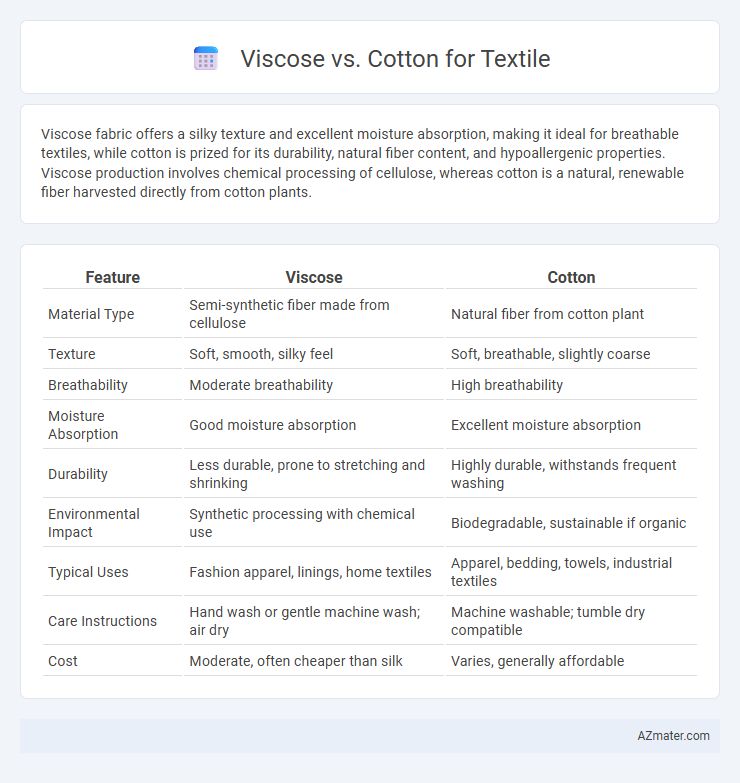Viscose fabric offers a silky texture and excellent moisture absorption, making it ideal for breathable textiles, while cotton is prized for its durability, natural fiber content, and hypoallergenic properties. Viscose production involves chemical processing of cellulose, whereas cotton is a natural, renewable fiber harvested directly from cotton plants.
Table of Comparison
| Feature | Viscose | Cotton |
|---|---|---|
| Material Type | Semi-synthetic fiber made from cellulose | Natural fiber from cotton plant |
| Texture | Soft, smooth, silky feel | Soft, breathable, slightly coarse |
| Breathability | Moderate breathability | High breathability |
| Moisture Absorption | Good moisture absorption | Excellent moisture absorption |
| Durability | Less durable, prone to stretching and shrinking | Highly durable, withstands frequent washing |
| Environmental Impact | Synthetic processing with chemical use | Biodegradable, sustainable if organic |
| Typical Uses | Fashion apparel, linings, home textiles | Apparel, bedding, towels, industrial textiles |
| Care Instructions | Hand wash or gentle machine wash; air dry | Machine washable; tumble dry compatible |
| Cost | Moderate, often cheaper than silk | Varies, generally affordable |
Introduction to Viscose and Cotton
Viscose is a semi-synthetic fiber derived from cellulose, primarily sourced from wood pulp, offering a soft texture and high breathability similar to natural fibers. Cotton, a natural fiber harvested from cotton plants, is known for its durability, moisture absorption, and hypoallergenic properties. Both fibers serve as fundamental materials in textile manufacturing, each providing distinct benefits for comfort and versatility in clothing and home textiles.
Origins and Production Processes
Viscose is a semi-synthetic fiber derived from regenerated cellulose found in wood pulp, predominantly from fast-growing trees such as beech, pine, and eucalyptus, undergoing chemical-intensive processes like steeping, shredding, and xanthation. Cotton is a natural fiber harvested from the seed hairs of the cotton plant, primarily grown in countries like India, China, and the United States, where it requires mechanical harvesting and ginning to separate fibers from seeds. The production of viscose involves solvents like carbon disulfide and sulfuric acid, which raise environmental concerns, whereas cotton cultivation depends heavily on water, pesticides, and labor-intensive farming practices.
Fiber Structure and Composition
Viscose fibers are regenerated cellulose fibers derived from wood pulp, featuring a semi-synthetic structure with a smooth, cylindrical shape that allows excellent dye absorption and a silky texture. Cotton fibers are natural cellulose fibers composed primarily of cellulose with a twisted ribbon-like structure that provides breathability, softness, and high moisture absorption. The key difference lies in their origin and fiber morphology, where viscose offers high luster and drapability, while cotton excels in durability and natural comfort.
Softness and Comfort Comparison
Viscose offers a silky, smooth texture that enhances softness compared to the natural fiber cotton, often making it feel more luxurious against the skin. Cotton provides breathable comfort with excellent moisture absorption, promoting airflow and reducing irritation for sensitive skin. Viscose's softness is ideal for draping and flowy garments, while cotton's durability and natural hypoallergenic properties ensure long-lasting comfort in everyday wear.
Breathability and Moisture Absorption
Viscose offers excellent breathability due to its semi-synthetic cellulose fibers, allowing air circulation comparable to cotton but with a silkier texture. Cotton excels in moisture absorption, capable of absorbing up to 27 times its weight in water, making it highly effective for sweat management and comfort. While both fibers provide breathability, cotton's natural composition enhances its ability to wick moisture and maintain dryness during prolonged wear.
Durability and Longevity
Viscose, made from regenerated cellulose fibers, offers a soft and smooth texture but tends to have lower durability compared to cotton, as it is more prone to wear and tear over time. Cotton fibers are naturally strong and resilient, providing enhanced longevity and resistance to repeated washing and friction, making it a preferred choice for long-lasting textiles. Fabrics made with cotton maintain their structural integrity better than viscose, especially in demanding applications such as apparel and home textiles.
Environmental Impact and Sustainability
Viscose production involves significant chemical processing and deforestation, leading to higher environmental degradation compared to sustainably sourced cotton, which relies on natural fibers with lower water and pesticide use. Cotton cultivation, especially organic varieties, offers better soil health and biodiversity benefits, reducing overall carbon footprint and pollution. While viscose can be biodegradable, its manufacturing process poses ecological challenges that make sustainably farmed cotton a more eco-friendly textile option.
Dyeing and Color Retention
Viscose fibers absorb dyes more readily than cotton, resulting in vibrant and rich color saturation that enhances fabric appeal. Cotton, composed of natural cellulose, holds color through strong chemical bonding but tends to fade faster due to moisture and light exposure. The dye retention in viscose outperforms cotton, making viscose textiles ideal for garments requiring long-lasting, bright colors.
Cost and Market Availability
Viscose is typically more affordable than cotton due to its semi-synthetic production from wood pulp, offering a cost-effective alternative in textile manufacturing. Cotton, being a natural fiber, often commands higher prices driven by agricultural factors, labor intensity, and market demand. The global market availability of viscose is widespread, supported by large-scale industrial production, while cotton supply is susceptible to seasonal and climatic variations affecting harvest yields.
Choosing Between Viscose and Cotton
When choosing between viscose and cotton for textiles, consider that viscose offers a silky texture and excellent draping properties, making it ideal for fashion and lightweight garments. Cotton excels in breathability, durability, and natural moisture absorption, suitable for everyday wear and bedding. Evaluate the end-use requirements, such as comfort, maintenance, and sustainability, to select the most appropriate fiber for your textile needs.

Infographic: Viscose vs Cotton for Textile
 azmater.com
azmater.com